1997 HONDA ODYSSEY ESP
[x] Cancel search: ESPPage 2 of 241

Introduction
Congratulations ! Your selection of a 1997 Honda Odyssey was a wise
investment. It will give you years of driving pleasure.
One of the best ways to enhance the enjoyment of your new Honda is to
read this manual. In it, you will learn how to operate its driving controls and
convenience items. Afterwards, keep this owner's manual in your vehicle so
you can refer to it at any time.
Several warranties protect your new Honda. Read the warranty booklet
and responsibilities.
Maintaining your vehicle according to the schedules given in this manual
helps to keep your driving trouble-free while it preserves your investment.
When your vehicle needs maintenance, keep in mind that your Honda dealer's staff is specially trained in servicing the many systems unique to
your Honda. Your Honda dealer is dedicated to your satisfaction and will be pleased to answer any questions and concerns. As you read this manual, you will
find information that is preceded by
symbol. This
information is intended to help you avoid damage to your Honda, other
property, or the environment.
a
NOTICE
thoroughly so you understand the coverages and are aware of your rights
ProCarManuals.comMain Menu s t
Page 3 of 241
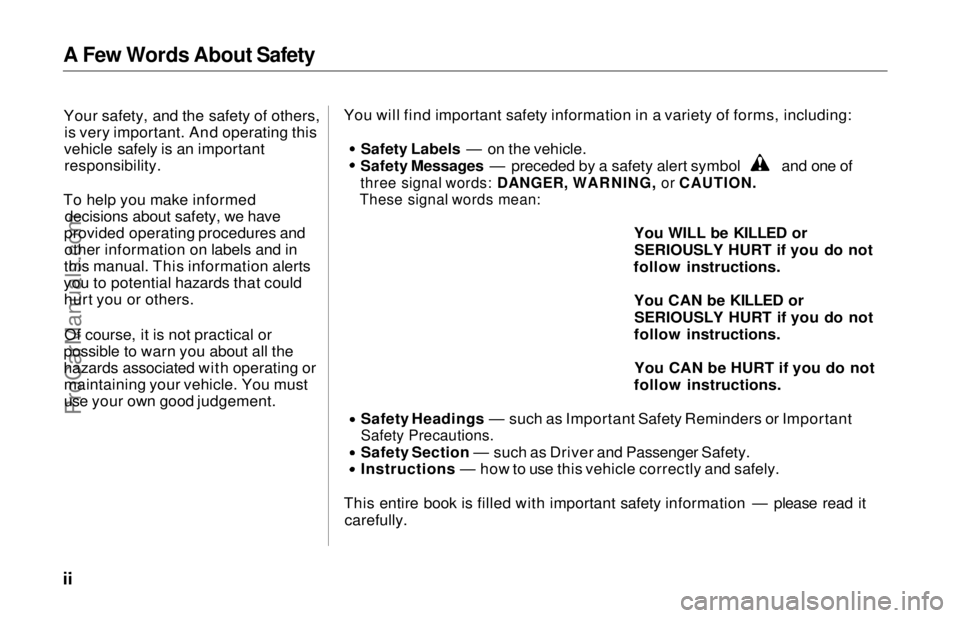
A Few Words About Safety
Your safety, and the safety of others, is very important. And operating this
vehicle safely is an important responsibility.
To help you make informed decisions about safety, we have
provided operating procedures and other information on labels and in
this manual. This information alerts
you to potential hazards that could hurt you or others.
Of course, it is not practical or
possible to warn you about all the
hazards associated with operating or maintaining your vehicle. You must
use your own good judgement. You will find important safety information in a variety of forms, including: Safety Labels — on the vehicle.
Safety Messages — preceded by a safety alert symbol and one of
three signal words: DANGER, WARNING, or CAUTION.
These signal words mean:
You WILL be KILLED orSERIOUSLY HURT if you do not
follow instructions.
You CAN be KILLED orSERIOUSLY HURT if you do not
follow instructions.
You CAN be HURT if you do not
follow instructions. Safety Headings — such as Important Safety Reminders or Important
Safety Precautions.
Safety Section — such as Driver and Passenger Safety.
Instructions — how to use this vehicle correctly and safely.
This entire book is filled with important safety information — please read it carefully.ProCarManuals.comMain Menu s t
Page 5 of 241
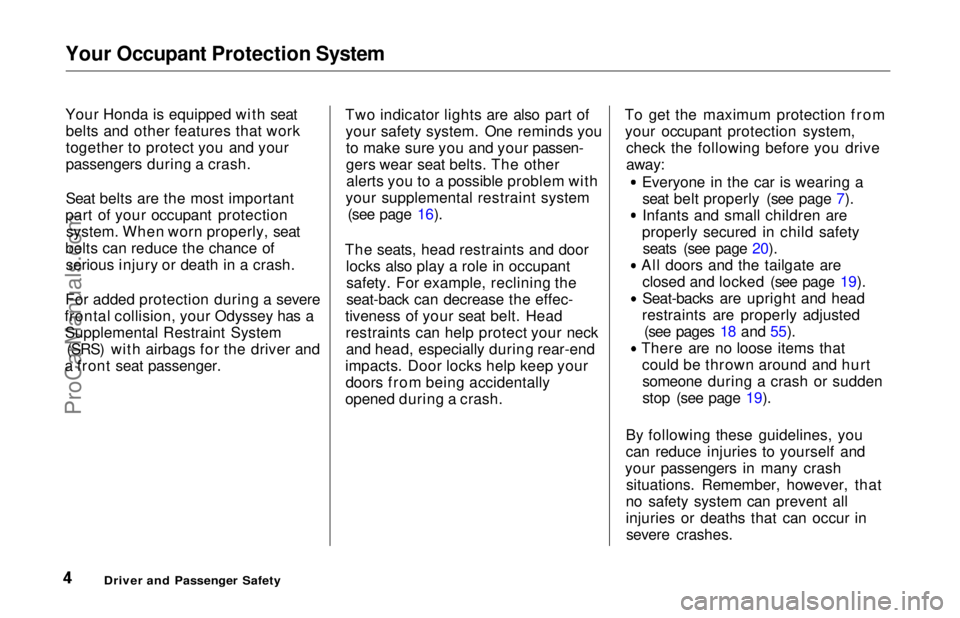
Your Occupant Protection System
Your Honda is equipped with seat
belts and other features that work
together to protect you and your
passengers during a crash.
Seat belts are the most important
part of your occupant protection system. When worn properly, seat
belts can reduce the chance of serious injury or death in a crash.
For added protection during a severe
frontal collision, your Odyssey has a Supplemental Restraint System (SRS) with airbags for the driver and
a front seat passenger. Two indicator lights are also part of
your safety system. One reminds youto make sure you and your passen-
gers wear seat belts. The otheralerts you to a possible problem with
your supplemental restraint system (see page 16).
The seats, head restraints and door locks also play a role in occupantsafety. For example, reclining the
seat-back can decrease the effec-
tiveness of your seat belt. Head restraints can help protect your neckand head, especially during rear-end
impacts. Door locks help keep your doors from being accidentally
opened during a crash. To get the maximum protection from
your occupant protection system, check the following before you drive
away:
Everyone in the car is wearing a
seat belt properly (see page 7). Infants and small children are
properly secured in child safety seats (see page 20). All doors and the tailgate are
closed and locked (see page 19). Seat-backs are upright and head
restraints are properly adjusted (see pages 18 and 55). There are no loose items that
could be thrown around and hurtsomeone during a crash or sudden
stop (see page 19).
By following these guidelines, you
can reduce injuries to yourself and
your passengers in many crash situations. Remember, however, that
no safety system can prevent all
injuries or deaths that can occur in severe crashes.
Driver and Passenger SafetyProCarManuals.comMain Menu Table of Contents s t
Page 14 of 241
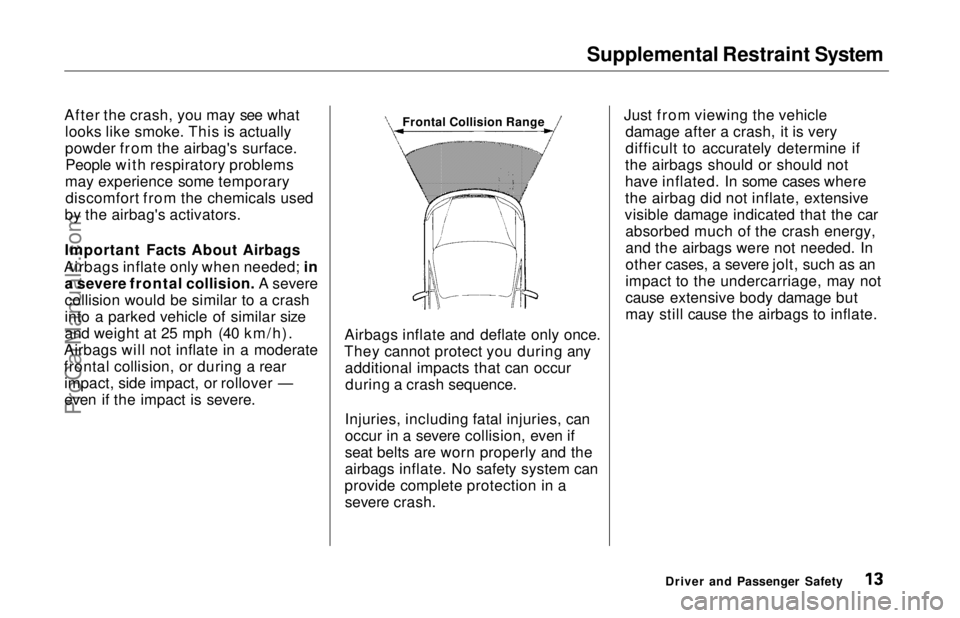
Supplemental Restraint System
After the crash, you may see what looks like smoke. This is actually
powder from the airbag's surface.People with respiratory problems
may experience some temporary discomfort from the chemicals used
by the airbag's activators.
Important Facts About Airbags
Airbags inflate only when needed; in a severe frontal collision. A severe
collision would be similar to a crash
into a parked vehicle of similar size
and weight at 25 mph (40 km/h).
Airbags will not inflate in a moderate
frontal collision, or during a rear impact, side impact, or rollover —
even if the impact is severe. Airbags inflate and deflate only once.
They cannot protect you during any additional impacts that can occurduring a crash sequence.
Injuries, including fatal injuries, can
occur in a severe collision, even if
seat belts are worn properly and the
airbags inflate. No safety system can
provide complete protection in a severe crash. Just from viewing the vehicle
damage after a crash, it is very
difficult to accurately determine if
the airbags should or should not
have inflated. In some cases where
the airbag did not inflate, extensive
visible damage indicated that the car absorbed much of the crash energy,
and the airbags were not needed. In
other cases, a severe jolt, such as an
impact to the undercarriage, may not
cause extensive body damage but
may still cause the airbags to inflate.
Driver and Passenger Safety
Frontal Collision RangeProCarManuals.comMain Menu Table of Contents s t
Page 20 of 241

Additional Safety Information
Door Locks
It is not safe to leave your car doors
unlocked. A passenger, especially a
child, could open a door and acci- dentally fall out. Also, there is a
greater chance of being thrown out of the car during a crash when the
doors are not locked.
Storing Cargo Safely
Before you drive, make sure you
first securely store or tie down any
items that could be thrown around
the car and hurt someone, or
interfere with your ability to operate
the controls.
Be sure to keep compartment doors
closed when the car is moving. If a
front passenger hits the door of an open glove box, for example, he
could injure his knees.
For information on loading cargo,
see page 116. Driving with Pets
Loose pets can be a hazard while you
are driving. An unrestrained pet can
interfere with your ability to drive
the car. In a crash or sudden stop, loose pets or cages can be thrownaround inside the car and hurt you or
your passengers. It is also for their safety that pets should be properly
restrained in your car.
The recommended way to restrain a medium-sized or larger dog is with aspecial traveling harness. This har-
ness can be secured to the rear seat
with a seat belt. Travel harnesses are available at pet stores.
A small dog, cat, or other small animal will be safest in a pet carrier
with rigid sides. Choose a style that allows you to secure it to the car's
seat by routing a seat belt through
the carrier's handle. For further information, contact your
veterinarian or local animal protec- tion society.
Driver and Passenger SafetyProCarManuals.comMain Menu Table of Contents s t
Page 53 of 241
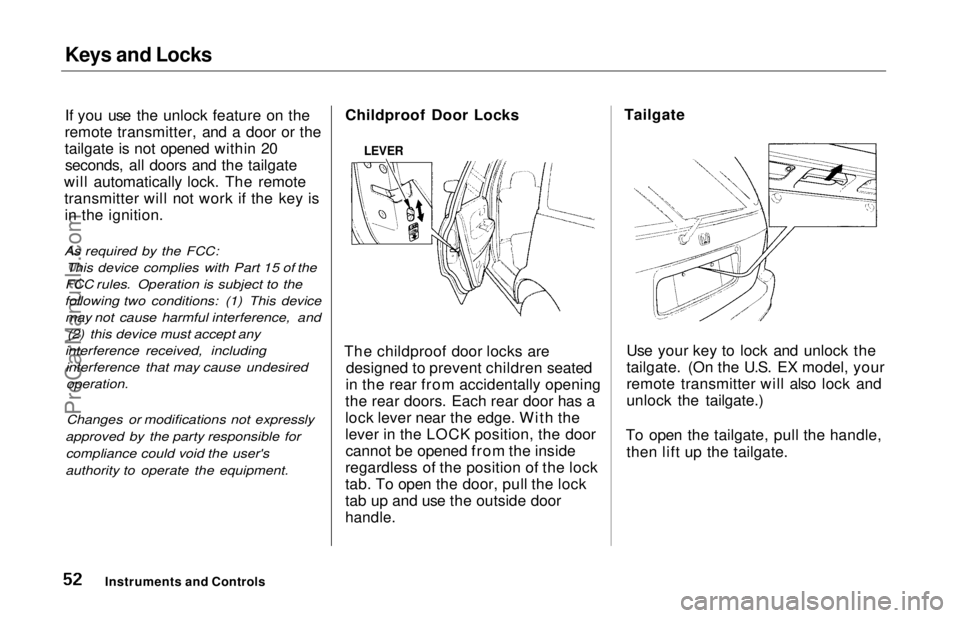
Keys and Locks
If you use the unlock feature on the
remote transmitter, and a door or the
tailgate is not opened within 20 seconds, all doors and the tailgate
will automatically lock. The remote transmitter will not work if the key isin the ignition.
As required by the FCC: This device complies with Part 15 of the
FCC rules. Operation is subject to the
following two conditions: (1) This device may not cause harmful interference, and (2) this device must accept any
interference received, including interference that may cause undesired operation.
Changes or modifications not expressly
approved by the party responsible for compliance could void the user's
authority to operate the equipment.
Childproof Door Locks
The childproof door locks are designed to prevent children seated
in the rear from accidentally opening
the rear doors. Each rear door has a
lock lever near the edge. With the
lever in the LOCK position, the door cannot be opened from the inside
regardless of the position of the lock
tab. To open the door, pull the lock
tab up and use the outside door
handle.
Tailgate
Use your key to lock and unlock the
tailgate. (On the U.S. EX model, your
remote transmitter will also lock and
unlock the tailgate.)
To open the tailgate, pull the handle, then lift up the tailgate.
Instruments and Controls
LEVERProCarManuals.comMain Menu Table of Contents s t
Page 73 of 241
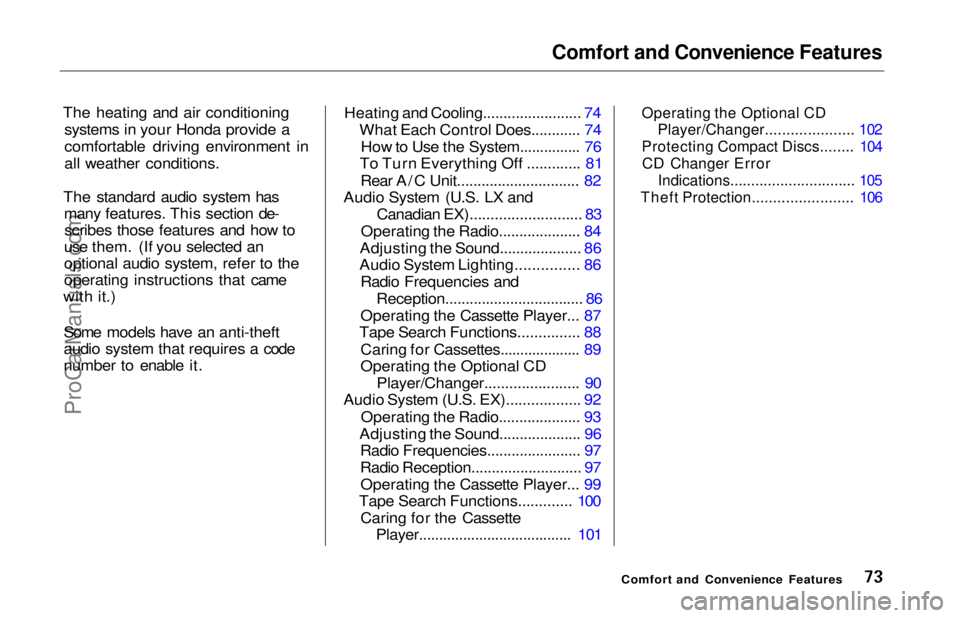
Comfort and Convenience Features
The heating and air conditioning systems in your Honda provide a
comfortable driving environment in
all weather conditions.
The standard audio system has many features. This section de-scribes those features and how to
use them. (If you selected an
optional audio system, refer to the
operating instructions that came
with it.)
Some models have an anti-theft
audio system that requires a code
number to enable it. Heating and Cooling........................ 74
What Each Control Does............ 74How to Use the System............... 76
To Turn Everything Off ............. 81
Rear A/C Unit.............................. 82
Audio System (U.S. LX and
Canadian EX)........................... 83
Operating the Radio.................... 84
Adjusting the Sound.................... 86
Audio System Lighting............... 86
Radio Frequencies and Reception.................................. 86
Operating the Cassette Player... 87
Tape Search Functions............... 88
Caring for Cassettes.................... 89
Operating the Optional CD Player/Changer....................... 90
Audio System (U.S. EX).................. 92
Operating the Radio.................... 93
Adjusting the Sound.................... 96 Radio Frequencies....................... 97
Radio Reception........................... 97
Operating the Cassette Player... 99
Tape Search Functions............. 100
Caring for the Cassette Player...................................... 101
Operating the Optional CD
Player/Changer..................... 102
Protecting Compact Discs........ 104
CD Changer Error
Indications.............................. 105
Theft Protection........................ 106
Comfort and Convenience FeaturesProCarManuals.comMain Menu Table of Contents s t
Page 75 of 241
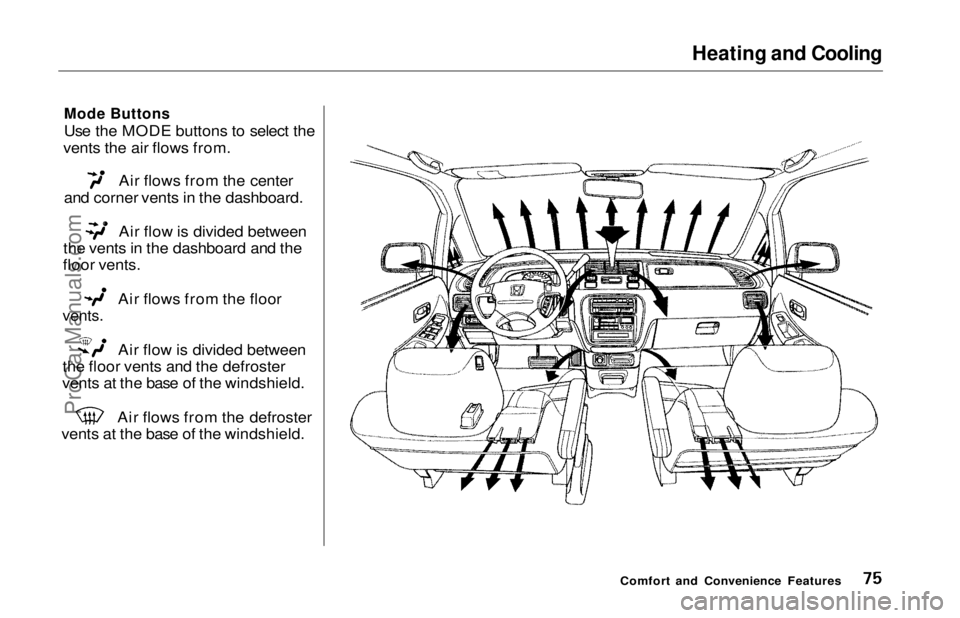
Heating and Cooling
Mode Buttons
Use the MODE buttons to select the
vents the air flows from. Air flows from the center
and corner vents in the dashboard. Air flow is divided between
the vents in the dashboard and the
floor vents. Air flows from the floor
vents.
Air flow is divided between
the floor vents and the defroster
vents at the base of the windshield. Air flows from the defroster
vents at the base of the windshield.
Comfort and Convenience FeaturesProCarManuals.comMain Menu Table of Contents s t